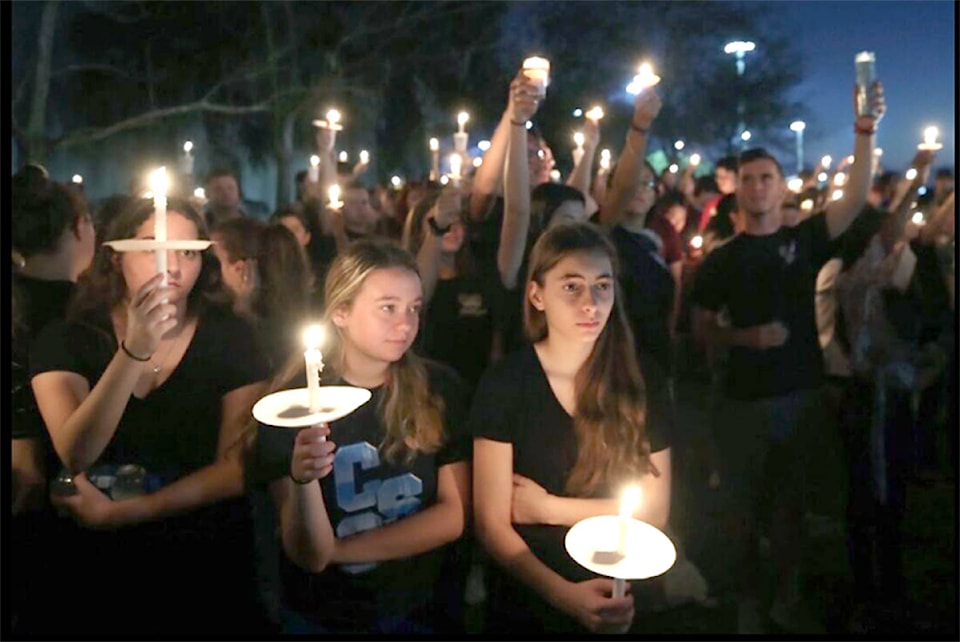Yme Woensdregt
Two years ago, on February 14, a gunman opened fire with a semi–automatic rifle at Marjory Stoneman Douglas High School in Parkland, Florida. He killed 14 students and 3 staff members and injured 17 other people. It was another horrific massacre, something which has become all too common.
I was remembering this event this past week, and what struck me again with renewed force is what happened afterwards. As happens altogether too frequently, people came together a few days later to remember those who died, to grieve their premature passing, and to lament the violence that seems to be accelerating. They were asking why we have to do this again.
I watched the event on television. It was largely planned by teenagers, those most directly affected. I was moved by their courage. Even through the screen, I could feel the heaviness of the moment, which befitted the gravity of the moment.
But there was something else — a palpable sense of defiant joy. As the memorial service began, 17 local students came to the microphone. Each of them spoke the name of a teenager or adult who was murdered. One of the young speakers approached the microphone and said, “I am happy to be here today. I am not happy because of why we gather. I am happy because I came here for hope …” He slowly scanned the crowd —and then continued “…and here you are.”
I can still feel the awe and emotion of that moment. These young people were speaking and doing something beautiful in response to something which was ugly and pointless. They were boldly affirming life in the face of senseless death. They were calling on legislators to also affirm life by banning the ridiculously easy purchase of guns and other instruments of death.
Each student, after speaking the name of someone who was killed, would light a candle, and then cradled it against their chest as they walked to the nearby State Capitol at the head of the assembled crowd.
This is what people of faith, morality, and conscience do. We are the stewards of hope in times when that hope seems most vulnerable. In such moments, our hope seems so frail.
Hope is very much like a flickering candle. A single puff of wind can blow it out. At the same time, the light from a single candle is enough to enlighten a room. A single candle pierces the darkness.
A Chinese proverb reminds us that “It is better to light a single candle than curse the darkness.” A candle is a small answer to a large problem, but it is a worthy and valuable step in the right direction.
Light is such a strong image in many religious traditions: Christianity, Islam, Judaism, Hinduism, Buddhism, and others. Light emanates from the divine, and is a symbol for wholeness and courage, illumination and hope. Light is the source of goodness and illuminates the way. Light is a symbol of that deep wisdom which is able to penetrate to the truth. As Psalm 119 reads, “Your word is a lamp to my feet and a light to my path.”
There are many festivals of light in the world’s religions — Hanukkah in Judaism, and Diwali in Hinduism. For Christians, light is a particularly prominent symbol during Advent and Christmas. John’s gospel says of Jesus that “The light shines in the darkness, and the darkness did not overcome it.”
That’s the reason why many Christians begin the new year with the Advent wreath. It is an evergreen circle (the symbol for eternity, being without end) which contains four candles and a candle in the centre.
Some people think that the four candles stand for different things: the Candle of Hope, the Candle of Joy, the Candle of Peace, and the Candle of Love. You may have seen something like that in your church. But that’s actually quite a late development.
The candles don’t merely “stand for” something else. We light the candles, and light is a primal symbol. In Advent, the church begins a new year. We begin the year in darkness. It’s hard to imagine that after Edison, but it was thus before electricity. Then we light one flickering candle. In each successive week of Advent, we light another candle … and then another … and then another. Finally, on Christmas Eve, we light all five candles, and proclaim that the Light of the World has come.
It is a statement of deep trust and hope that these few fragile flickering candles are enough to light up the world. As followers of Jesus, the Light of the World (John 1), we also become the light of the world (Matthew 5). We are joined to Christ, and we participate in his identity as people who become symbols and agents of life and light and hope in the midst of the darkness—just like these students from Marjory Stoneman Douglas High School.
It’s just a candle, we may be tempted to think. But it’s more than that. These students are agents of hope in our world, and the candles they carried were a sign of that hope. If we have the same courage as they have, we will be inspired by them to dare to hope in such a powerful way.
And that kind of hope will lead to actions of peace and resistance to the darkness. We are people who carry a small candle in the midst of the storm. We keep that hope close to our chests, protecting it from the winds and the weather that threaten to snuff it out. We show up in the small spaces of our daily life, we give what we are able, and we remind others that all is not lost, that this is not the end of the story.
Those who carry candles … become heroes.
Yme Woensdregt is Pastor at Christ Church Anglican in Cranbrook
